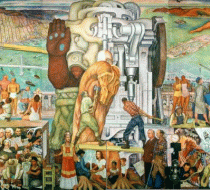Pan American Unity Favorite
The Stanford Daily:
There is no word short of “spectacular” that better describes the experience of examining “Pan American Unity,” Diego Rivera’s 1940 mural, housed since 2021 at the San Francisco Museum of Modern Art (SFMOMA). The piece is the crux of SFMOMA’s soon-closing exhibition, “Diego Rivera’s America,” curated by James Oles and Maria Castro.
The mural, whose full name is “The Marriage of the Artistic Expression of the North and of the South on This Continent,” is an extremely vibrant and honest piece of art. Seventy feet wide and 22 high, this vast work is Rivera’s ode to the Bay Area and his last fresco in the United States. Depicting the passage of time across North America, Rivera shares his vision for cultural solidarity with various groups across the continent. Rivera describes his work as the “fusion between the great past of the Latin American lands, as it is deeply rooted in the soil and the high mechanical developments in the United States.” Full of rich detail, this mural serves as an inherently activist piece and is both a fitting and exciting opener for the exhibit.
“[The fresco] is encoded with historic DNA. The mechanisms that happen in history are here,” mural historian William Maynez said. He marveled at the breadth of the piece — he still notices new things every day even after serving as steward and historian of the mural for more than 22 years.
The main exhibit itself is as meaningful as the mural. “Diego Rivera’s America” is split into 10 galleries, each of which represents a different theme that Rivera emulated in his works. These include places like Manhattan or Tehuantepec, as well as subjects like craftspeople or street markets.
Bay Area connections are the heart and soul of the exhibit, as well as an important aspect of Rivera’s life. Furthermore, the show focuses on the representation of North, Central and South American people.
Beyond having the opportunity to encounter the stunning quality of Rivera’s murals, it is equally fascinating to consider his vision for the future and the activist nature of his art. Rivera was a strong opponent of creating “art for art’s sake” and instead aimed to create change by softening viewers’ prejudices. It is by unapologetically including commentary on historical events such as World War II in pieces like “Pan American Unity” that Rivera is able to achieve this.
Focusing on Rivera’s work from 1921 to 1940 and bringing together 150 of his most regarded works, the exhibit guides viewers through the maturation of the artist’s style, rejection of the western art historical canon, and fight for greater social equality.
One of the most stunning aspects of the exhibition is its use of projections. The overture piece of the exhibit is Rivera’s mural “Creation,” displayed to the audience in a way never before experienced. SFMOMA utilizes a technique called “projection mapping,” a technological technique to display videos on various surfaces, to achieve the feat. Through a 1000-square-foot projection on the museum wall, curators were able to recreate the feeling of seeing the original mural as if viewers were visiting the Bolívar Auditorium of the National Preparatory School in Mexico City, where the original is housed. Next to the projection are sketches and early drafts of small pieces of the mural, mostly compiled by a Bay Area collector, standing as proof that San Francisco has been a part of Rivera’s journey even before he arrived in the Bay Area.
Another of the projected murals is the famous “Allegory of California,” Rivera’s first San Francisco fresco. The piece shows the workers of California in many different fields — agriculture, mining and mechanics, as well as education — represented by famous figures in the fields from the history of California. Much of the fresco is dominated by a woman who is a symbol of the rolling hills of the state.
Not only do the projected murals preserve the beauty of the originals, but they are also modernized with the addition of movement within the projections. In front of “Creation” are additional projections of musicians practicing their instruments, and “Allegory of California” displays long-haired women descending long staircases. Visitors are fully immersed in the context the works sit in, experiencing Rivera’s works in their full glory.
These projections enable the viewers to be immediately transported to the sites of Rivera’s most influential works. Although the show is not a full retrospective of Rivera’s work, the juxtaposition of projections and physical copies of his works offer viewers a comprehensive summary of his art from the time he returned to Mexico to his last mural in the U.S.







